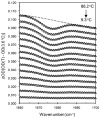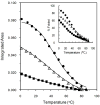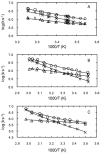Infrared study of the stability and folding kinetics of a series of β-hairpin peptides with a common NPDG turn
- PMID: 22136248
- PMCID: PMC3278157
- DOI: 10.1021/jp2046867
Infrared study of the stability and folding kinetics of a series of β-hairpin peptides with a common NPDG turn
Abstract
The thermal stability and folding kinetics of a series of 15-residue β-hairpins with a common Type I [3:5] NPDG turn were studied using Fourier transform infrared spectroscopy (FTIR) and laser-induced temperature jump (T-jump) with infrared detection, respectively. Mutations at positions 3, 5, or 13 in the peptide sequence SEXYXNPDGTWTXTE, where X represents the position of mutation, were performed to study the roles of hydrophobic interactions in determining the thermodynamic and kinetic properties of β-hairpin folding. The thermal stability studies show a broad thermal folding/unfolding transition for all the peptides. T-jump studies indicate that these β-hairpin peptides fold in less than 2 μs. In addition, both folding and unfolding rate constants decrease with increasing strength of hydrophobic interactions. Kinetically, the hydrophobic interactions have more significant influence on the unfolding rate than the folding rate. Φ-value analysis indicates that the hydrophobic interactions between the side chains are mainly formed at the latter part of the transition-state region during the folding process. In summary, the results suggest that the formation of the native structure of these β-hairpins depends on the correct topology of the hydrophobic cluster. Besides the formation of the turn region as a key process for folding as suggested by previous studies, a hydrophobic collapse process may also play a crucial role during β-hairpin folding.
© 2011 American Chemical Society
Figures





Similar articles
-
Understanding the key factors that control the rate of beta-hairpin folding.Proc Natl Acad Sci U S A. 2004 Nov 9;101(45):15915-20. doi: 10.1073/pnas.0405904101. Epub 2004 Nov 1. Proc Natl Acad Sci U S A. 2004. PMID: 15520391 Free PMC article.
-
Understanding the mechanism of beta-hairpin folding via phi-value analysis.Biochemistry. 2006 Feb 28;45(8):2668-78. doi: 10.1021/bi052039s. Biochemistry. 2006. PMID: 16489760
-
Infrared study of the stability and folding kinetics of a 15-residue beta-hairpin.J Am Chem Soc. 2003 Dec 17;125(50):15388-94. doi: 10.1021/ja037053b. J Am Chem Soc. 2003. PMID: 14664583
-
beta-hairpin-forming peptides; models of early stages of protein folding.Biophys Chem. 2010 Sep;151(1-2):1-9. doi: 10.1016/j.bpc.2010.05.001. Epub 2010 May 6. Biophys Chem. 2010. PMID: 20494507 Free PMC article. Review.
-
Insights into stabilizing weak interactions in designed peptide beta-hairpins.Biopolymers. 2004;76(2):185-95. doi: 10.1002/bip.10577. Biopolymers. 2004. PMID: 15054898 Review.
Cited by
-
How quickly can a β-hairpin fold from its transition state?J Phys Chem B. 2014 Mar 27;118(12):3317-25. doi: 10.1021/jp500774q. Epub 2014 Mar 17. J Phys Chem B. 2014. PMID: 24611730 Free PMC article.
-
Directly monitor protein rearrangement on a nanosecond-to-millisecond time-scale.Sci Rep. 2017 Aug 18;7(1):8691. doi: 10.1038/s41598-017-08385-0. Sci Rep. 2017. PMID: 28821738 Free PMC article.
-
Using thioamides to site-specifically interrogate the dynamics of hydrogen bond formation in β-sheet folding.J Am Chem Soc. 2012 May 16;134(19):8026-9. doi: 10.1021/ja301681v. Epub 2012 May 2. J Am Chem Soc. 2012. PMID: 22540162 Free PMC article.
References
Publication types
MeSH terms
Substances
Grants and funding
LinkOut - more resources
Full Text Sources

